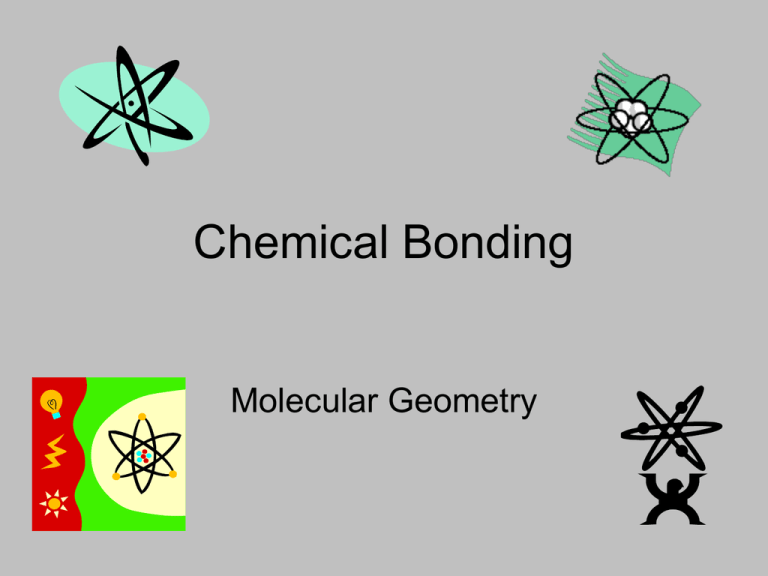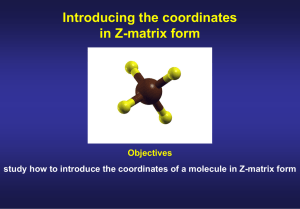File
advertisement

Chemical Bonding Molecular Geometry What is Molecular Geometry? • The study of the physical structure, bonding, and shapes of molecules. • Involves the connection between formula, valence, hybridization, and bonding. • Is governed by the Valence Shell Electron Pair Repulsion theory… So what is this Valence Shell Electron Pair Repulsion Theory?? • A statement that essentially says that electron pairs do not like each other. – Why would that be true ???? The Result… • Electron Pairs around a central atom will be oriented in space to be as far apart (from each other) as possible. Example #1 – A molecule with the formula AX2 This molecule has two bonds. • What hybrids will enable this? (sp hybrids) • What will the valence be around the central atom after the bonding? (4) • How will the bond pairs be arranged in space to follow the VSEPR? X A X What is the bond angle X-A-X in this molecule? (180 degrees) What is the name given to describe the shape of this molecule? (linear) Example #2 – A molecule with the formula AX3 This molecule has 3 bonds: • What hybrids will be needed to form the three bonds? (sp2) X X Side View •What will the valence be around the central atom after the bonding? (6) • How will the bond pairs be arranged in space to follow the VSEPR? X X A X X Top View Example #2 – A molecule with the formula AX3 X X What will the bond angle, X-A-X be in this molecule? (120°) A Is the molecule symmetrical in shape? (yes) X What name will be given to the shape of the molecule? (trigonal planar) Example #3 – A change to 3dimensional thinking… Given: A molecule with the formula AX4 • How many bonds are there in the molecule? (4) • What was the valence of the central atom before the hybridization? (4) • What will the valence be around the central atom after the bonding? (8) What hybrids are used to form these bonds? (sp3) What element could be the central atom in this molecule? (C or Si) The Lewis Dot Diagram for the AX4 molecule would look like this: X X A X X But, that is two dimensional thinking…. Here is what really happens… The molecule is not “flat” like a Lewis Dot Diagram would suggest. Instead, the “X” atoms are at the corners of a regular tetrahedron. X A X X X The shape of the molecule is described as tetrahedral and the bond angle is 109.5 degrees Continuing: The AX5 Molecule First things first: How many bonds are formed? (5) What hybrids are used? (sp3d) What is the valence around the central atom after all of the bonding? (10) What elements could be the central atom in the molecule? Why just these? (P, As - b/c they have d orbitals available) X X X A X X Now for the 3-dimensional version: There is obviously a lot going on here… 1. We define axial and equatorial atoms. X X X X X 2. We define an axial bond angle as 180 degrees. 3. We define an equatorial bond angle as 120 degrees. 4. Note that the axis and the equatorial plane are perpendicular. 5. The complete molecule is described as having a trigonal bipyramidal shape. How to draw the AX5 molecule: You should visualize the drawing as having the central atom where the “hole” is and the “X” atoms at the ends of the axis and also at the corners of the triangle. We commonly call this representation the “Pizza on a Stick” model. Finally, the AX6 molecule. There are obviously 6 bonds here: 1. What hybrids does the central atom use? (sp3d2) 2. What elements are capable of hybridizing this way? (S, Se) 3. What will the valence be around the central atom once the bonding has occurred? (12) 4. What would a Lewis Dot Diagram of this molecule look like? X X X A X X X Now in 3 Dimensions. If you look carefully (imagine…) there are 8 faces in this structure. We name this shape “octahedral”. All of the bond angles are 90 degrees. The molecule is fully symmetrical. How we draw the molecule. for now….








